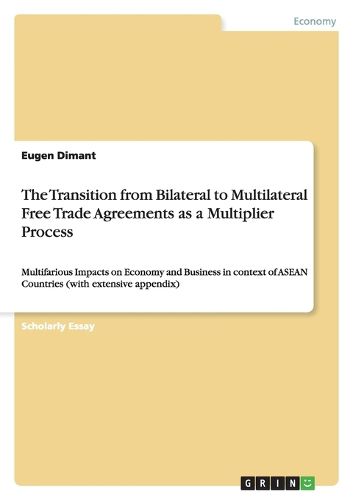Readings Newsletter
Become a Readings Member to make your shopping experience even easier.
Sign in or sign up for free!
You’re not far away from qualifying for FREE standard shipping within Australia
You’ve qualified for FREE standard shipping within Australia
The cart is loading…






Scientific Essay from the year 2010 in the subject Economics - Foreign Trade Theory, Trade Policy, grade: 97.5%, Ottawa University, course: Multinational Business Policy, language: English, abstract: Stemming from the ongoing globalization, the process of global integration and international trade has accelerated ever since. Where back in the days the trade was more or less bounded to inter-regional trade with customers, partners and countries in close proximity, nowadays goods are shipped throughout the world, costs of transportation have decreased, time to market has increased and thus the needs and desires can be served almost instantly throughout the world particularly because of the continuous support of the WTO, where a plethora of bilateral and regional trading and economic cooperation agreements have been mushrooming globally, and increasingly in the Asia-Pacific, generating a wave of new regionalism in Asia (Sen; Srivastava 2009: 194). Concerned by the Asian financial crisis in 1997-1998, the ASEAN countries were under the impression of a slowdown in pace of trade liberalization and thus this put pressure on these countries to engage sustainably in mutual beneficial trade and economic integration. By that, at a theoretical level regional economic integration is being taken to mean deepening of intra-regional trade, expansion of mutual foreign direct investment (FDI) and harmonization of commercial regulations, standards and practices. (Ekanayake; Veeramacheneni 2009: 2). This proceeding integration in ASEAN has mainly been motivated by the intention to create an attractive production base and to satisfy the rising competitive challenge on the part of China and India for both, domestic and foreign companies. (Hew; Sen 2004: 1-2). The impact especially of the ASEAN countries has raised over time, mainly in comparison to the OECD countries. At the same time that developing Asia s share in ASEAN trade has been rising substantially (from about one-third t
$9.00 standard shipping within Australia
FREE standard shipping within Australia for orders over $100.00
Express & International shipping calculated at checkout
Scientific Essay from the year 2010 in the subject Economics - Foreign Trade Theory, Trade Policy, grade: 97.5%, Ottawa University, course: Multinational Business Policy, language: English, abstract: Stemming from the ongoing globalization, the process of global integration and international trade has accelerated ever since. Where back in the days the trade was more or less bounded to inter-regional trade with customers, partners and countries in close proximity, nowadays goods are shipped throughout the world, costs of transportation have decreased, time to market has increased and thus the needs and desires can be served almost instantly throughout the world particularly because of the continuous support of the WTO, where a plethora of bilateral and regional trading and economic cooperation agreements have been mushrooming globally, and increasingly in the Asia-Pacific, generating a wave of new regionalism in Asia (Sen; Srivastava 2009: 194). Concerned by the Asian financial crisis in 1997-1998, the ASEAN countries were under the impression of a slowdown in pace of trade liberalization and thus this put pressure on these countries to engage sustainably in mutual beneficial trade and economic integration. By that, at a theoretical level regional economic integration is being taken to mean deepening of intra-regional trade, expansion of mutual foreign direct investment (FDI) and harmonization of commercial regulations, standards and practices. (Ekanayake; Veeramacheneni 2009: 2). This proceeding integration in ASEAN has mainly been motivated by the intention to create an attractive production base and to satisfy the rising competitive challenge on the part of China and India for both, domestic and foreign companies. (Hew; Sen 2004: 1-2). The impact especially of the ASEAN countries has raised over time, mainly in comparison to the OECD countries. At the same time that developing Asia s share in ASEAN trade has been rising substantially (from about one-third t